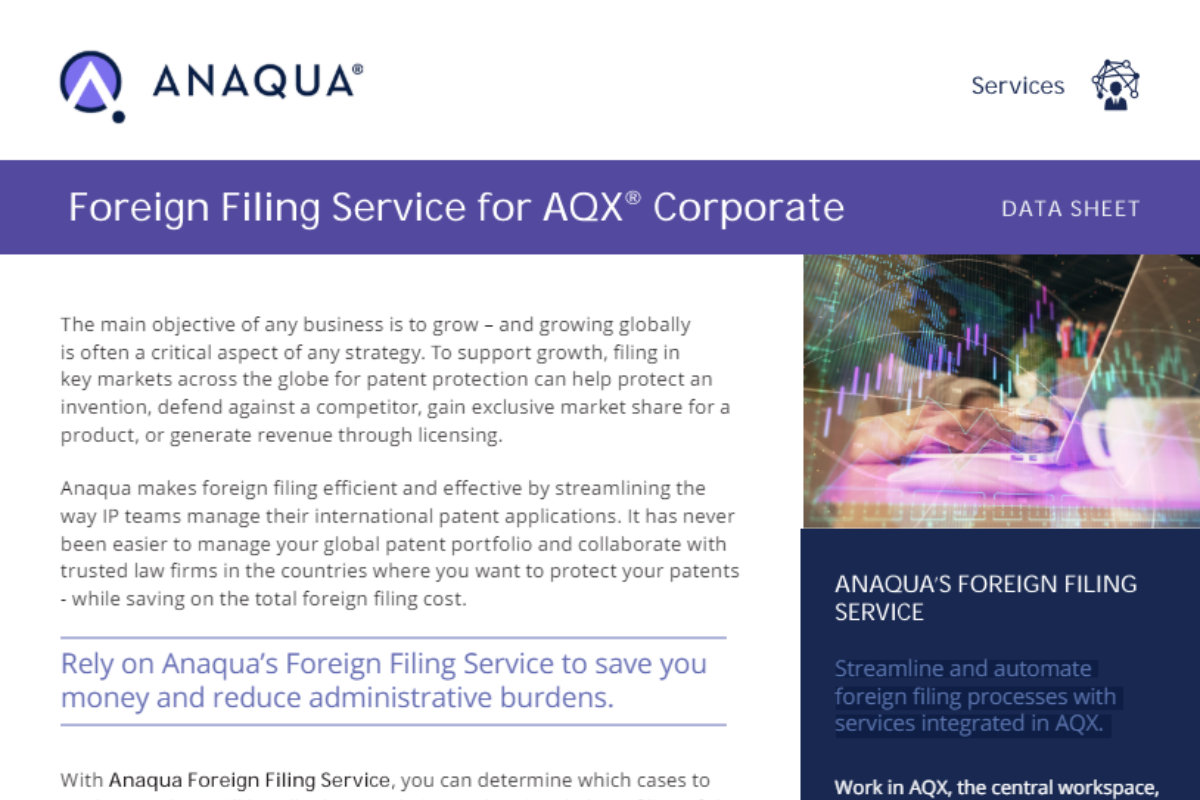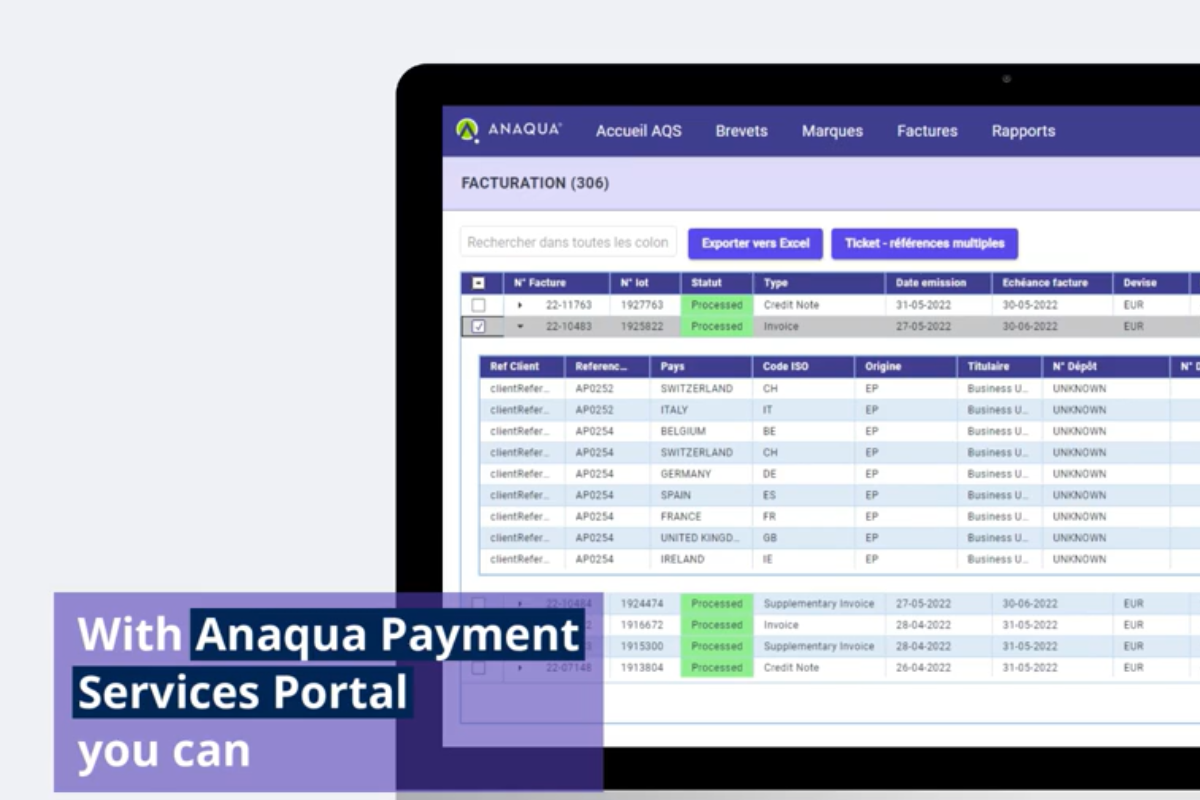Guiding Principles for Effective Foreign Filing
The main objective of any business is to grow – and growing globally is often a critical aspect of that strategy. To support growth, filing in key markets across the globe for patent protection can help ensure the invention is protected, defend against a competitor, gain exclusive market share for a product, or generate revenue through licensing.
Companies often embark on foreign patent filing without having done the proper due diligence and planning. Corporations need an iterative, cost-effective approach to remain competitive in their requisite markets. This article discusses five key areas to consider in developing a foreign patent filing strategy.
- Determine where to file
- Know the competition and market
- Control IP costs and manage time
- Keep an eye on the changing international landscape
- Optimize international patent filing processes
1. Determine Where to File
First, determine if foreign patent protection aligns with your overall business plan. Understanding your company’s expansion strategy, and the products that would be sold through that expansion is critical when determining a filing strategy. Knowing where the product will be sold and not sold, who the competitors are in those markets, and the short, mid, and long-term plans are just some of the factors that must be considered. With this information in hand, the IP department can devise a plan.
Blanketing the entire world in patent coverage isn’t practical or cost-effective. Consider filing in the major revenue-opportunity markets for the company’s primary industries. By identifying jurisdictions with high concentrations of valuable patents in technologies in your industry, the patent will likely be worth filing in that location.
For example: acquiring protection throughout all of Europe isn’t useful if you don’t plan to operate throughout all of Europe. There is a strategic decision to make regarding the market and whether you are leaving revenue at risk - and whether it would be detrimental if that market was lost to a competitor.
Take the time needed to perform a thorough review of your current approach and filing objectives. A better understanding of these goals can help shape the strategy for the coming quarter, year, and longer-term goals.
2. Know The Competition and Market – Identify Their Position and Strategy
Obtaining a clear view of the competition’s IP position in each relevant jurisdiction significantly impacts a filing strategy. It also aids in determining if it makes sense to move into or continue in a specific jurisdiction.
There should be a deliberate balance of quality patent protection and sufficient space for growth when assessing in which jurisdictions to focus your company’s international filing efforts. The density of patents for a particular technology due to a high level of competition in a jurisdiction, as well as potential enforcement proceedings, may also indicate a lack of room for growth. Therefore, the density of patents should be considered before deciding to file a foreign filing patent.
A calculated foreign filing strategy can force a competitor to produce their product somewhere with higher costs or lower technological manufacturing capabilities. Therefore, protection in a low-cost manufacturing jurisdiction may have value beyond maximizing revenue. Key questions to ask:
- Is your focus on protecting your business, preventing competition from encroachment, and enforcing your IP rights?
- What is your competition doing in a particular jurisdiction?
- Do you have the means to enforce your rights if needed?
3. Control IP Costs and Manage Time
Efficiency and affordability are key to an international filing strategy due to prosecution time and expense implications. Pursuing international patent protection can be an expensive endeavor, but it also requires managing many new deadlines by your IP team. Although it may not require drafting a new application if it is based on a corresponding U.S. application and filed within 1 year, the overall filing and prosecution can become quite expensive over time.
Certain jurisdictions require translations into their languages, payment of fees in their currencies, and working with local agents in their jurisdictions. It’s not just about managing fees - but also managing time. Acquiring patent protection in some jurisdictions can take 48 to 84 months after an initial U.S. filing. The key questions here are:
- How much time does your IP team spend tracking deadlines with local agents?
- What transparency do leaders in your organization have into the foreign filing budget?
- How can you pace your spending when it comes to secondary foreign filings?
For each patent, considering the path to obtaining protection is critical. Leveraging vehicles such as the Patent Cooperation Treaty (PCT), European Patent (EP), and the upcoming Unitary Patent (UP) can help pace your cash flow and better manage timelines. For more than a few countries the Patent Cooperation Treaty (PCT) covers most of the world and enables you to defer the major filing costs for up to 18 months.
4. Keep an Eye on the Changing International Landscape
The fast-changing intellectual property landscape can be challenging for organizations to navigate. These are just three examples - and there are many – of why it is critical to keep an eye on the changing IP environment.
- The Unitary Patent will enable IP teams – for the first time – to obtain a single patent in the EU (European Union) and is set to start in June 2023. Initially, pursuing the Unitary Patent may seem a simple decision, but there could be many pros and cons to consider.
- In the face of global economic uncertainty, companies may look to cut costs or start pruning their innovation portfolios without proactively putting in place approaches and plans that ensure resilience. One approach could involve looking at ways to create greater collaboration or processes to speed up decision-making around your filing strategies.
- For Artificial Intelligence (AI) inventions, there are different laws and regulations and still no global standard. The EU has developed the EU AI Act which could over time become a worldwide standard. This is another area to watch to ensure your organization is ready.
It's important to be prepared to adjust your strategy as the latest information becomes available about laws and regulations that will impact foreign patent filing. Additionally, be prepared that as your company moves into new jurisdictions, or expands filing in current jurisdictions, the workload naturally becomes more complex with additional prosecution deadlines and maintenance decisions.
5. Optimize Internal Patent Filing Processes
When you consider what goes into whether to file outside your home country, the process often starts when the business does a periodic review of the IP portfolio. The amount of time and tasks that IP teams spend on foreign filing activities after the portfolio review and decisions have been made should not be underestimated.
Paralegals, the docketing team, and your IP administration can spend multiple hours every day managing agent relationships, managing communications and documentation, tracking down orders, and trying to meet upcoming filing deadlines. Obtaining an estimate for just one case may require numerous emails back and forth with an agent and then assembling this information to share with other team members.
- What standardized processes or automated workflows does your organization have in place to manage the workload?
- Is your team prepared to handle an increase in the administrative tasks associated with foreign filings?
- Do you anticipate having more resources to manage foreign filings in the upcoming year?
Assessing internal work processes and looking for areas where these processes can be streamlined are key to addressing this issue. Maintaining focus on improving operational processes can have many benefits such as improved efficiency and productivity, and better visibility into workflow processes.
Key Takeaways
Making decisions to file patents in multiple countries can be a complex process, as it should be closely aligned with your company’s growth strategy. Ultimately, developing a foreign patent filing strategy requires a thorough analysis of the selected markets, associated costs, the competition’s position, the probability of success in obtaining a patent grant, and, most importantly, the value derived from the patents secured. In summary, a few key takeaways are:
- Maintain a working knowledge of your company’s IP portfolio to make smart filing decisions upfront.
- Keep a clear view of your competitive IP position in each relevant jurisdiction.
- Assess goals and budgetary requirements associated with foreign filing activity in a particular market.
- Adapt the foreign patent filing strategy based on the ever-changing IP landscape.
- Optimize internal foreign filing procedures by reviewing current tools and processes.
Watch this Video to Learn How Anaqua Can Help.




